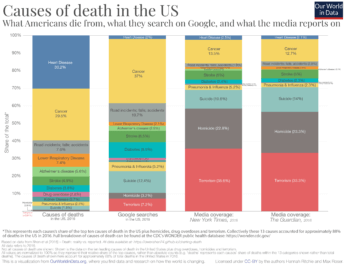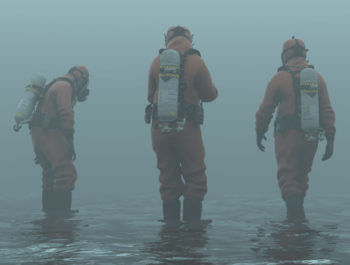Moment of Surprise: The Anatomy of Biomedical Risk
As the emergence and rapid spread of coronavirus show, pandemic preparedness can anticipate biomedical risks but never quite pre-empt them. More generally, human imagination mobilises the past in an attempt to reimagine it and predict the future but it can never anticipate the moment of surprise, the moment when risk moves from the realm of active (often fearful) imagination to concrete manifestation. The only temporal dimension in which potential risks can be meaningfully understood is the “here and now”.
Risk is a sociological enigma. It is theoretically intricate, philosophically deep, and conceptually complex. As a cultural trope risk anchors human experience into an impossible conundrum: on the one hand risk behooves us to predict, prevent and prestidigitate a future purged of risk itself and on the other hand the very act of doing so makes the task of formulating action to neutralise probable, predictable or apparent risks a critical challenge. The task is challenging because the triumvirate of hope, expectation and anticipation circumscribes acts of mediating and managing risks. The mitigating calculus of biomedical risk management, and risk management more generally, turns hope, a wilful wish, into an expectation oriented toward a predetermined future scenario and (biomedical/technological) capabilities that in turn anticipate potential surprise, shock and threat to human health via preemptive anticipatory action.
 FIGURE 1 | CAUSES OF DEATH IN THE US. What Americans die from, what they search on Google, and what the media reports on.
FIGURE 1 | CAUSES OF DEATH IN THE US. What Americans die from, what they search on Google, and what the media reports on.The Emergence of Risk Society
The work of human imagination actively formulates risk to mean something rather specific in specific contexts. For instance, risk management is a mid-20th-century, postwar concern that rapidly expanded in the closing decades of the past century. However, hope for a risk-free future produces risk expectations that can at best be anticipated. The emergence of “risk society” doctrine in the 1980s is a fine illustration, as it shifted the focus to risk-suffused futures made imaginable as a by-product of rapid modernity itself. The reason risk to human health is a complex phenomenon, nurtured in specific socioeconomic and cultural assemblages, is because human imagination cannot anticipate the moment of surprise. In the realm of risk management the one thing that can never be anticipated is the moment of surprise itself That is, the moment when risk moves from the realm of active (often fearful) imagination to concrete manifestation. How does one preempt surprise, anticipate it? In other words, in the realm of risk management the one thing that can never be anticipated is the moment of surprise itself. To produce knowledge responsive to biomedical and other risks in the anticipatory mode is to relentlessly infuse and diffuse an imagined future of surprise. The mysterious emergence of coronavirus and its rapid spread is an example in point as to how risks can be anticipated (pandemic preparedness) but never quite preempted. To live with risk is to live in mortal fear of the moment of surprise. We can say we lead lives suffused with risks that are often unknown (origin), mostly unknowable (causation) and continually unfolding (affliction). To live with (health) risk therefore is to live with uncertainty.
THE NEED TO OVERCOME THE ELUSIVENESS OF RISK
In the post-COVID 21st century, humanity’s “risky future” will be actively reimagined. It is essential to understand that risk perceptions and risk projections are often responsive to material class interests and socioculturally bestowed privileges (or lack thereof). These interests shape how we apprehend past encounters with risk to second-guess future risk scenarios. In the late neoliberal capitalist modernity, the concept of risk has been actively debated as a reflexive mode of self-understanding, both individual and societal. In particular the materially privileged social formations coopted this mode to protect their interests and wellbeing, as illustrated by the lack of universal health insurance coverage in the United States. In addition to the vexed questions of equity and justice, this is a problematic turn as risk inhabits a perplexing temporality where the reflexive experience of the past can seldom predict the future and the future can at best be consciously preempted. Simply put, mobilising the past contributes to reimagining it and predicting the future often forestalls it. The only temporal dimension in which potential risks can be meaningfully understood is the “here and now”. In displacing risk into an unknowable future, societies and cultures merely prepare themselves for the moment of surprise; a moment when all calculations, algorithms, projections and predictions crumble at the door of a unique occurrence. In this sense the future pandemics are gestating in the here and now, in our wanton destruction of rainforests and glaciers. It is no good projecting them into the future where the moment of surprise will laugh in the face of our purported preparedness. The coronavirus is mutating in the here and now, it is useless to expect and hope that a vaccine will be effective against future alterations. In a similar vein, human fertility is declining in the here and now due to a complex mix of socioeconomic inequalities and forced mass migrations.

The impact of environmental pollution (notably microplastics and CO2 emissions) on reproductive morphology, hormonal imbalances, plummeting sperm counts is both worrying and poorly understood. The countries of the South, once routinely chastised and stigmatised in the mid-20th-century development discourse for irresponsible and unchecked fertility, have sounded a low-frequency early warning over declining fertility. Across the developing world major cities are slowly stagnating at replacement-level fertility. The Himalayan nation of Nepal has in fact slipped below that level. This ought to force a radical rethink on established but simplistic policy prescriptions favouring active pronatalism in the imagined subfertile North and aggressive antinatalism in the purportedly overpopulated South.we fear and anticipate future risks because we fail to grasp the structural contexts gestating risks in the present
The future risks to human population growth, health and viability (as a socioeconomic entity) are staring us in the face. However, we fear and anticipate future risks because we fail to grasp the structural contexts gestating risks in the present. Rather than focusing on futures suffused with risks, we must attend to how our risk-laden and destructive social, political and economic practices incubate a florid spectrum of pathogens and a host of manmade afflictions. It is imperative we pause and assess how a certain form of human sociality and polity is risking human health. An unyielding virus or a plastic-infested planet impacting human health and fertility is a mere moment of unanticipated surprise announcing its risky presence. And in so doing, defying the arrogance implicit in the late-modern sociality adept at fostering grandiose and delusional modes of risk prognostications.
